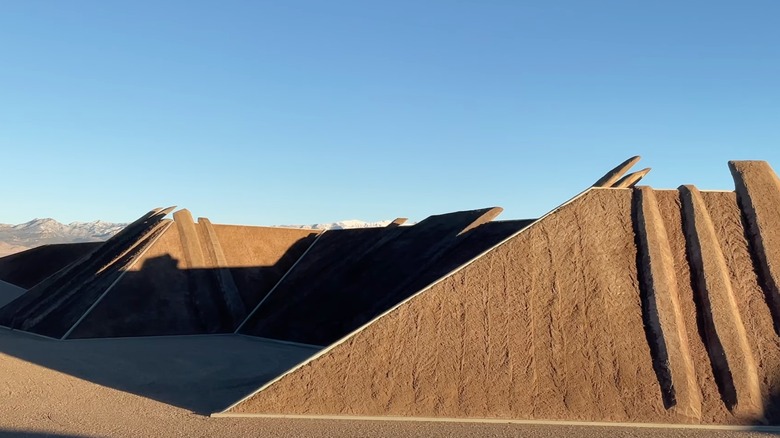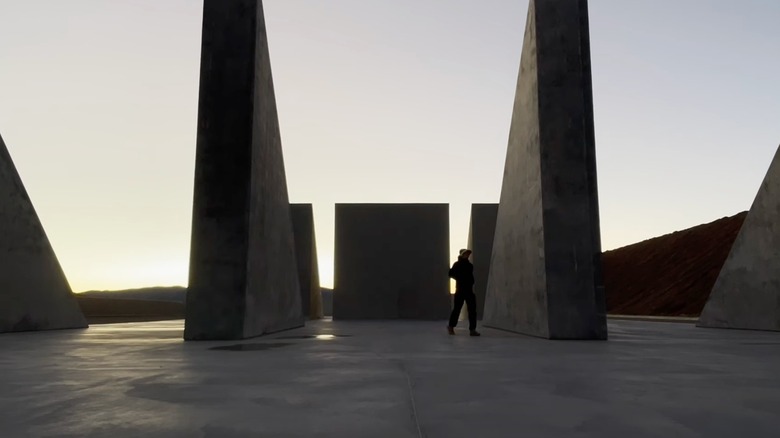One Of The Largest Artworks In The World Is This Mysterious Secret 'City' In Nevada
Beneath the restless Nevada sun lies a creation that seems almost out of place — a city with no inhabitants, a monument with no clear purpose. Michael Heizer's "City" remains one of the most ambiguous masterpieces of modern art. Like a phantom, it looms just out of reach, yet lures you in closer and closer with its sheer magnitude. Stretching more than a mile and a half, "City" seems to sprawl across the desert floors like a forgotten civilization lost in time.
It's not a city for the living, nor is it a cenotaph for the dead. "City" is an enigma, a place that seems to defy understanding. What is it? Why is it there? And why do we gravitate toward it? This is a mysterious place that leaves you with more questions than answers, with an eerie sense of timelessness you just can't explain.
Of course, Heizer's creation is hidden deep in the remote desert, not far from Area 51, one of the most-visited attractions in America and a surreal Nevada mind trip. For those coming from Las Vegas, it's a 157-mile drive north, taking about 4 hours with stops along the way. From Austin, Nevada — an idyllic, living ghost town — you'll head south for 5 hours through desolate landscapes before reaching this destination. Even after the journey, the suspense continues — visitors are picked up in the quiet town of Alamo, then dropped off at "City." Don't expect any souvenirs, either — the location remains shrouded in secrecy.
Heizer's City disrupts the desert silence
When you arrive at "City," the scale of the work is immediately apparent — the colossal sculpture dominates the Nevada desert. Designed to blend ancient monumentality with modern minimalism, "City" is constructed using the land's raw materials such as dirt, sand, rock, and concrete. It almost merges industrial technology with its natural surroundings.
The first impression is that "City" is both familiar and completely alien. The natural state of the materials draws comparisons to historic sites like Chichen Itza in Yucatan, which inspired Heizer's vision. The site is divided into five phases, filled with large structures called complexes. While there's no obvious layout or path to follow, each has its own peculiar features.
Some of these structures reach up to 80 feet in height, with jagged pyramidal shapes that rise from the ground. You'll notice the massive concrete forms set in depressions and shapes connected by long lines of concrete that snake through the desert. Together, they form paths and patterns across the space. One of the standout areas is Complex One, a massive dirt mound bordered by concrete walls. Another striking feature is the geoglyphs — these are carved right into the desert and created using different granulations of sand. The best way to appreciate these patterns is from above.
Tips for visiting City in Nevada
If you wish to visit "City," you must submit a reservation request to the Triple Aught Foundation (TAF). Upon approval, you'll receive detailed instructions regarding how to proceed. Make sure to bring water, sunscreen, and snacks for the drive, as there are no facilities on-site — TAF even recommends using the restroom before you leave. Only six lucky people are allowed inside "City" per day, on Tuesdays, Wednesdays, and Thursdays. No photography is allowed, so don't bother bringing a camera either.
Once there, you'll have three hours to explore the isolated artwork and disconnect from distractions. You'll quickly understand why the artist chose this far-off location — the Heizers have called this state home since the 1800s, and its solitude allows the piece to exist in harmony with the vast expanse around it. The materials used in "City" were sourced from the vicinity, with little to no impact on the environment to preserve the native plants and wildlife. Heizer started by financing the megaproject himself, but over time, art institutions and collectors lent their support to contribute to its ongoing development.
The result is a work that's in sync with the land, delivering an experience that's both personal and profound. The images of "City" may only exist in your memory, so take your time to absorb the views. But if it's photos you're after, make your way to Rhyolite, one of the best-preserved and most photographed ghost towns in Nevada.

